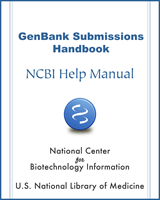NCBI Bookshelf. A service of the National Library of Medicine, National Institutes of Health.
The GenBank Submissions Handbook [Internet]. Bethesda (MD): National Center for Biotechnology Information (US); 2011-.
This publication is provided for historical reference only and the information may be out of date.
Choosing the Appropriate Submission Resource
Submission Tools
BankIt vs. Sequin vs. tbl2asn
When should I use BankIt for submissions? When should I use Sequin or tbl2asn?
Expressed Sequence Tags
Which submission tool should I use if I want to submit Expressed Sequence Tags (ESTs)?
Genome Survey Sequences
Which submission tool should I use if I want to submit Genome Survey Sequences (GSSs)?
Barcode Sequences
First-pass sequence data generated from a single cosmid, BAC, YAC, or PAC clone
Flatfiles generated using a non-NCBI tool
Learn about GenBank Records before you Submit
What’s the difference between a GenBank record and a RefSeq record?
Choosing the Appropriate Submission Resource
Submission Tools
BankIt vs. Sequin vs. tbl2asn
When should I use BankIt for submissions? When should I use Sequin or tbl2asn?
You should use BankIt if:
You should use Sequin if:
You should use tbl2asn if:
Once you have decided which of these tools you’d like to use for your submission, see the “Submitting Sequences using Specific NCBI Submission Tools” section of this Quick Start guide for brief explanations of each of the different submission processes as well as links to useful material.
See the GenBank Sample Record page, which provides all GenBank Record field definitions.
Expressed Sequence Tags
Which submission tool should I use if I want to submit Expressed Sequence Tags (ESTs)?
ESTs should be submitted through the database of Expressed Sequence Tags (dbEST) submission system.
You may wish to look at the ““Submitting Sequences using Specific NCBI Submission Tools” section of this Quick Start guide for a brief description of the dbEST submission process, and links to useful material.
I have computationally assembled mRNA sequence reads from primary data such as ESTs, traces, and Next Generation Sequencing Techonologies. Where do I submit my assembly?
You can submit your assembly to the Transcriptome Shotgun Assembly (TSA) Sequence Database using the process described on the TSA home page.
Genome Survey Sequences
Which submission tool should I use if I want to submit Genome Survey Sequences (GSSs)?
GSSs should be submitted through the database of Genome Survey Sequences (dbGSS) submission system.
dbGSS contains (but is not limited to) genomic sequences from the following types of data:
You may wish to look at the “Submitting Sequences using Specific NCBI Submission Tools” section of this Quick Start guide for a brief description of the dbGSS submission process, and for links to useful material.
Barcode Sequences
What are “Barcode” sequences, and where are they submitted?
Barcode sequences, determined as part of the Barcode of Life initiative, are short nucleotide sequences from a standard genetic locus for use in species identification. Currently, the Barcode sequence being accepted for animals is a 5', 658 base pair region of the mitochondrial cytochrome oxidase subunit I (COI) gene.
The Barcode Submission tool provides for streamlined online submission of Barcode sequences into GenBank. With this tool, you can:
First-pass sequence data generated from a single cosmid, BAC, YAC, or PAC clone
Where do I submit unfinished DNA (e.g. first-pass sequence data generated from a single cosmid, BAC, YAC, or PAC clone) sequences?
An unfinished collection of DNA sequence data derived from a single cosmid, BAC, YAC or PAC clone that may contain one or more gaps, can be submitted to the High Throughput Genomic (HTG) sequence division of GenBank. The HTG division contains unfinished high-throughput clone-based DNA sequences that are available in GenBank and for BLAST similarity searches against the "HTGS" database.
A single accession number is assigned to sequence data generated from a single clone; each HTG record provides a user with the HTG sequence status and a flag that the sequence data are "unfinished" and may contain errors.
If you want to submit data to the HTG division of GenBank, review the HTG submission documentation, as well as HTG FAQs, both of which can be accessed using links located on the HTG home page. There is a brief overview of the HTG submission process in this Quick Start as well.
Note: The HTG submission system releases all submissions immediately after processing – you cannot set a release date in advance. If you need to set a release date for your submission, you must submit using the standard GenBank submission pathway.
If you would like more information about submitting to the HTG division of GenBank, contact the HTG division at: vog.hin.mln.ibcn@nimda-sgth .
Flatfiles generated using a non-NCBI tool
Can I submit a flat file to GenBank created using a NCBI tool if the file generated looks just like Sequin output or looks just like a GenBank flat file?
GenBank cannot accept flat files created using non-NCBI tools for the following reasons:
Please submit properly formatted ASN.1 files.
Learn about GenBank Records before you Submit
How do I find definitions for all the fields in a GenBank Record so I know what they are before I begin the GenBank submissions process?
To explore the definitions the fields in a GenBank Record before you start your submission, go to our online example of a GenBank record, and click on any of the light blue links to see the field definitions.
What’s the difference between a GenBank record and a RefSeq record?
The complete original publication describing RefSeq is available on PubMed Central.
- Before Starting the Submission Process - The GenBank Submissions HandbookBefore Starting the Submission Process - The GenBank Submissions Handbook
Your browsing activity is empty.
Activity recording is turned off.
See more...
